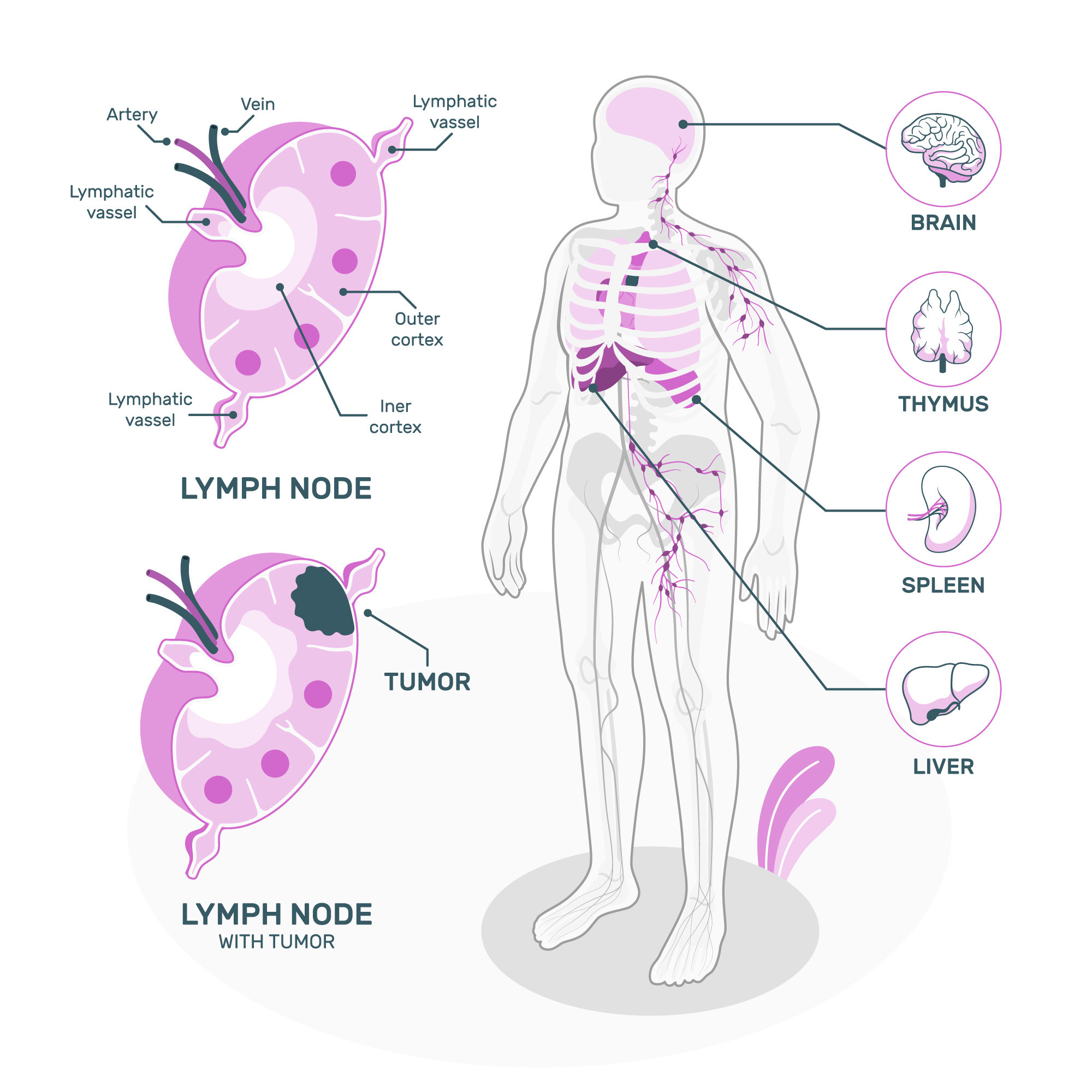Definition
Abdominal wall tumors refer to the proliferation of abnormal cells within the abdominal wall. They can arise from abdominal and pelvic organs, including the liver, gallbladder, digestive tract, and ovaries, and can also develop in the abdominal wall. These tumors can originate from various mechanisms, such as physical trauma or injury, infection, and aberrant cellular proliferation. The predominant types of abdominal wall tumors are desmoid tumors, lipomas, metastatic cancers, endometriomas, and sarcomas.
Causes
Several factors can contribute to the development of tumors or masses on the abdominal wall, such as:
- Soft tissue cancers include both adipose (fat) and solid tumors. The most commonly encountered chest wall tumors are solid tissue tumors, such as desmoid tumors, sarcomas (malignant tumors), and endometriomas (tumors of the uterine wall lining). However, the most commonly found tumor that has a high amount of fat is called a lipoma. A lipoma is a noncancerous growth that can develop in many regions of the body.
- Cysts filled with fluid
- Endometriosis refers to the abnormal development of endometrial tissue, which comprises the interior lining of the uterus. One of the most common sites of endometriosis is the front abdominal wall, which typically develops in cesarean section wounds. This is possible as a result of the uterine stem cells that are implanted at the site of the surgical procedure.
- Hemangioma is a type of blood vessel tumor affecting the abdominal wall. It predominantly affects young adult males and is characterized by the presence of minute capillaries. Hemangiomas cannot progress to malignancy and, once removed, do not typically recur.
- Bruising of the abdominal muscles can result from surgical procedures performed on the abdominal wall, sudden or severe trauma, or injury. Conversely, platelet deficiency and using blood- thinners are additional conditions in which spontaneous bruising may happen.
- Metastasis of cancer to the gastric wall. Primary tumors with the potential to metastasize to the abdominal wall encompass melanoma (a type of skin cancer), pancreatic cancer, lung cancer, gastrointestinal cancer, urinary and reproductive tract cancer, and lymphoma. The primary etiology of stomach wall cancers is commonly attributed to metastasis from distant primary tumors.
- The spread of cancer from the abdominal cavity to the abdominal wall, either naturally or as a result of a laparotomy procedure.
- The condition is characterized by a severe infection in a deep wound or an abscess in the abdominal wall. An abscess is an accumulation of purulent fluid. Anterior abdominal wall abscesses typically arise from surgical procedures or develop from infected contusions. While uncommon, abscesses can also develop due to fungal infections or tuberculosis.
- Arterio-venous vascular malformations.
- An abdominal hernia occurs when the internal organs of the abdomen, typically the intestines, protrude through a weakened abdominal wall area. Hernias are the primary source of protrusions in the abdominal wall.
Risk factor
- Female. Females have a higher risk of desmoid tumors, while endometriomas only affect females. Women who previously had a cesarean section or surgery to remove the uterus are at a higher risk of developing endometriomas on the abdominal wall.
- Medical history of neoplasms or malignancies
- Hereditary predisposition to malignancies
- The historical development of tumor removal surgery
- History of biopsy
Symptoms
The symptoms vary depending on the underlying cause of the abdominal wall tumor, including:
- When the abdominal muscles are bruised, an excruciating lump will be felt. The pain will intensify while performing activities that induce contractions of the abdominal muscles. Additionally, redness may manifest on the skin.
- Visible manifestations of infections or abscesses include fever, erythema, discomfort, edema, and, occasionally, visible purulent discharge.
- Abdominal hernias are characterized by masses that can spontaneously retract or be manually reduced. Exerting pressure often causes the emergence of lumps. However, it is also possible that the lump cannot be reinserted later. This can lead to intestinal entrapment, resulting in obstruction of the digestive tract. Prolonged entrapment can cause damage to the affected section of the intestine.
- Due to their gradual growth, soft tissue tumors typically do not produce symptoms. Symptoms typically manifest when the tumor reaches a certain magnitude. These include a detectable mass on the abdomen wall, stomach discomfort, and other related signs.
- Endometriomas can induce symptoms characterized by menstrual cycle-related pain and typically manifest in women of reproductive age.
Diagnosis
To diagnose an abdominal wall tumor, the doctor will initially inquire about your medical history and the specific symptoms you are currently experiencing. Afterward, the doctor will perform a comprehensive physical examination, with a primary focus on the abdominal region, to detect and diagnose the tumor.
Further examinations may be performed, including blood tests, which may detect blood coagulation disorders (in patients taking blood-thinning medications) or infection, suggesting the tumor may be an abscess.
Radiological tests, such as ultrasonography, CT scans, and MRI, are commonly performed to investigate malignancies. Ultrasound can distinguish between solid tumors and tumors filled with fluid and detect the existence of a hernia. Concurrently, a CT scan can distinguish the composition of the lump, determining if it consists of adipose tissue, fluid-filled sacs (cysts), or dense tissue. MRI is the most effective diagnostic tool for assessing soft tissue tumors and detecting indications of malignancy.
A biopsy can be performed to identify your specific type of tumor if the doctor detects any signs.
Management
Depending on the underlying etiology, the following options are available for treating tumors in the abdominal wall:
- Antibiotics and pus drainage are the standard treatments for abdominal wall infections, sometimes known as abscesses.
- To avoid complications and recurrences, hernias must be surgically repaired.
- In cases of bruising in the abdominal muscles, medication, particularly blood thinners and factors that improve blood coagulation, will be administered under the doctor's supervision.
- Surgical excision of the tumor and surrounding healthy tissue is the typical approach for treating soft tissue tumors. Nevertheless, the treatment selection will be modified based on the kind (as determined by examining the biopsy results), size, and tumor location. In addition to surgical intervention, radiation therapy can be employed to mitigate the risk of recurrence.
Complications
Complications may manifest due to the tumor itself or the therapeutic interventions. Tumors can potentially metastasize to distant sites, particularly when they are sizable, early-stage, and recurrent.
Surgical wounds may develop complications during surgery, such as abscesses, which, if not treated, can lead to widespread infection. Another surgical consequence is the excision of the lymph nodes, which serve as the site for fluid outflow from the lower extremities, resulting in edema in the lower legs.
Prevention
Maintaining a healthy lifestyle, including a balanced diet, regular exercise, and stopping smoking, can help prevent abdominal wall tumors.
When to see a doctor?
Consult a doctor if you feel an abdominal wall tumor or mass or its symptoms. If you have a lump that goes in and out, abdominal pain, and trouble defecating, you should go to the hospital immediately because you may need surgery.
- dr Ayu Munawaroh, MKK
Abdominal Wall Mass | Quick Answers Surgery | AccessSurgery | McGraw Hill Medical. Accesssurgery.mhmedical.com. (2022). Retrieved 25 January 2022, from https://accesssurgery.mhmedical.com/content.aspx?bookid=853§ionid=49661971.
RadioGraphics. RadioGraphics. (2022). Retrieved 26 January 2022, from https://pubs.rsna.org/doi/full/10.1148/rg.2020190170.
Li, M., Zhang, L., Xu, X., Shi, Z., & Zhao, X. (2022). CT and MRI features of tumors and tumor-like lesions in the abdominal wall. Qims.amegroups.com. Retrieved 26 January 2022, from https://qims.amegroups.com/article/view/30244/26548.












